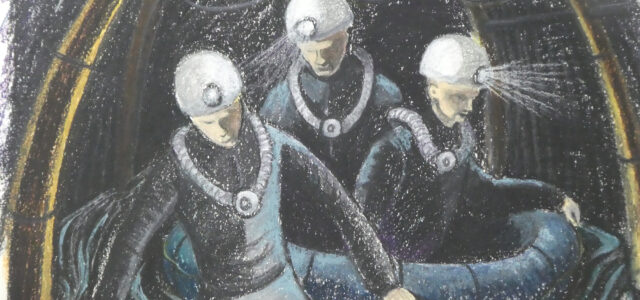
Bringing The Past To Life…
An exhibition of paintings based on historic commentaries from miners and their experiences, is set to open at the National Coal Mining Museum England
Ribble Valley-based artist Kevan Thompson has secured a prestigious exhibition at the National Coal Mining Museum (NCMM) England, which is based at the former site of the Caphouse Colliery in Wakefield.
In what is the 40th anniversary year of the 1984 controversial miners’ strike, the exhibition titled The Past is Gone But it is Not Lost, is set to open this month and features a collection of Kevan’s work that he created after listening to recorded accounts from miners: “As the son of a miner I witnessed first-hand the industrial actions of the 70s and 80s, walked the road from home to the pit head, seeing them emerge black from the hole, watched injured miners carried from the pit head, picked coal from the slag heaps in the dead of night and witnessed the factions developing between family and friends,” recalls Kevan. “I never became a miner but hold in adoration those who went down into the depths of an underground world, risking their lives for their families.”
The exhibition is the culmination of a project developed in collaboration with the NCMM, which houses the De Re Metallica, a book written more than 450 years ago describing working methods in metal mining – it is the oldest artefact in the museum. The NCMM also has a collection of oral histories, which Kevan was allowed access to. These gave him a unique insight into the lives of the miners’ and gave him inspiration for many of the paintings: “Discovering that the museum had an oral histories collection was a lightbulb moment for me,” says Kevan. “I spent several hours over a number of days at the museum listening to their stories and their accounts of various events. I started to gather information about what roles they played, there are various accounts of disasters, rescues and injuries. I have found some of the stories amusing, shocking and sometimes disturbing.”
Kevan also found that the accounts sparked memories from his childhood: “I have found myself recalling memories I once thought lost, re-connecting with the past to help preserve the underground existence of the miners.”
Many of the stories from the oral histories collection give vivid accounts of various disasters: “That got my attention. They ranged from the ridiculous to the horrific – there is one account of a mine inexplicably flooding and the rescue team could only get down in a rubber dinghy. They eventually had to abandon the operation.”
Each of the 22 paintings in the exhibition features accompanying sketches and written accounts from the oral histories collection. Each painting is worked in oil, pastel or charcoal: “While charcoal is a medium that perfectly fits the subject, it also works well aesthetically,” says Kevan, who first approached the NCMM back in 2022.
“I had previously done a painting of three exhausted miners – it was a large painting and I didn’t know what to do with it. I asked the museum if they wanted it. They said no, but six months later they contacted me asking if I would like to exhibit my work.
“I went over to Wakefield to meet with the museum staff, and it was then I found out about the oral histories collection. The museum arranged for me to have access to the histories and provided a small selection of typed transcripts so I could contextualise events in even more detail.”
One painting, Down Below Into the Dark, takes a perspective from above and focuses on the miners’ hard hats as they travel down in the cage into the depths: “That was inspired by a commentary from one miner who said he never saw the sun. It was overpowering. I also learnt that the cage travelled 40ft per second, which must have been pretty frightening.”
A number of the paintings are from Kevan’s personal memories: “During the strike of ’72 I remember having to go up to the nightshift picket line. The miners were all sitting around a blazing brazier to keep warm, which inspired the painting Nightshift.”
For Kevan, creating and preparing the paintings for the exhibition has been a huge, but enjoyable feat: “I have loved it and what’s more the people at NCMM like what they have seen so far. They are pleased that the oral histories collection has been used in a way which they had not previously been used.
“Through listening to them, I have sought to keep memories alive, to help relocate hidden histories and make them visible and ultimately to ensure they are … ‘not lost to us.’”
The Past is Gone But it is Not Lost runs from April until September 2024.

